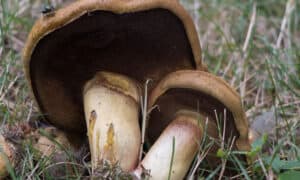Come along and discover 22 unique types of rare mushrooms worldwide. Some are incredibly rare and expensive, while others are fascinating.
There are over 14,000 types of fungi that create mushrooms throughout the world. Some are very common, while others are rare. Many are safe to eat, while others are toxic. Some look plain and simple, while others are interesting and even beautiful.
Fungi produce mushrooms — organisms that look like plants but are far more unique. Fungi are part of their kingdom, just like animals and plants. Mushrooms are the fruiting portion of fungi. In other words — they are the reproductive part of the organism.
Mushrooms release “seeds” called spores. The spores travel significant distances to produce more fungi and mushrooms. Spores come from the gills or pores underneath the mushrooms’ caps — the large “heads” of the mushrooms.
Mushrooms only live for a short time. Still, the fungi the mushrooms grow from can live for years, creating new mushrooms.
1. Nouhra’s Truffle-like Amanita (Amanita nouhrae)
The Amanita nouhrae mushroom is reportedly very rare. Experts estimate there only to be about 600 mature individuals. Despite these mushrooms being so rare, they should be able to grow in many regions. Yet, they only grow in Argentina and Chile.
The mushrooms become truffles that grow underground. Their bodies are white and ruffled, quite closely resembling a golf ball.
The genus Amanita is notorious for its toxicity. There isn’t enough information about the toxicity of this particular species, but experts don’t recommend eating it. Even if they were edible, it’s not a good idea since there are so few worldwide.
The International Union for the Conservation of Nature (IUCN) lists this mushroom as “vulnerable” with an “unknown” population trend.
These mushrooms face threats like deforestation of the Nothofagus forests, where they grow. They are also vulnerable due to forest fires and volcanic activity.
2. Amethyst Deceiver (Laccaria amethystina)
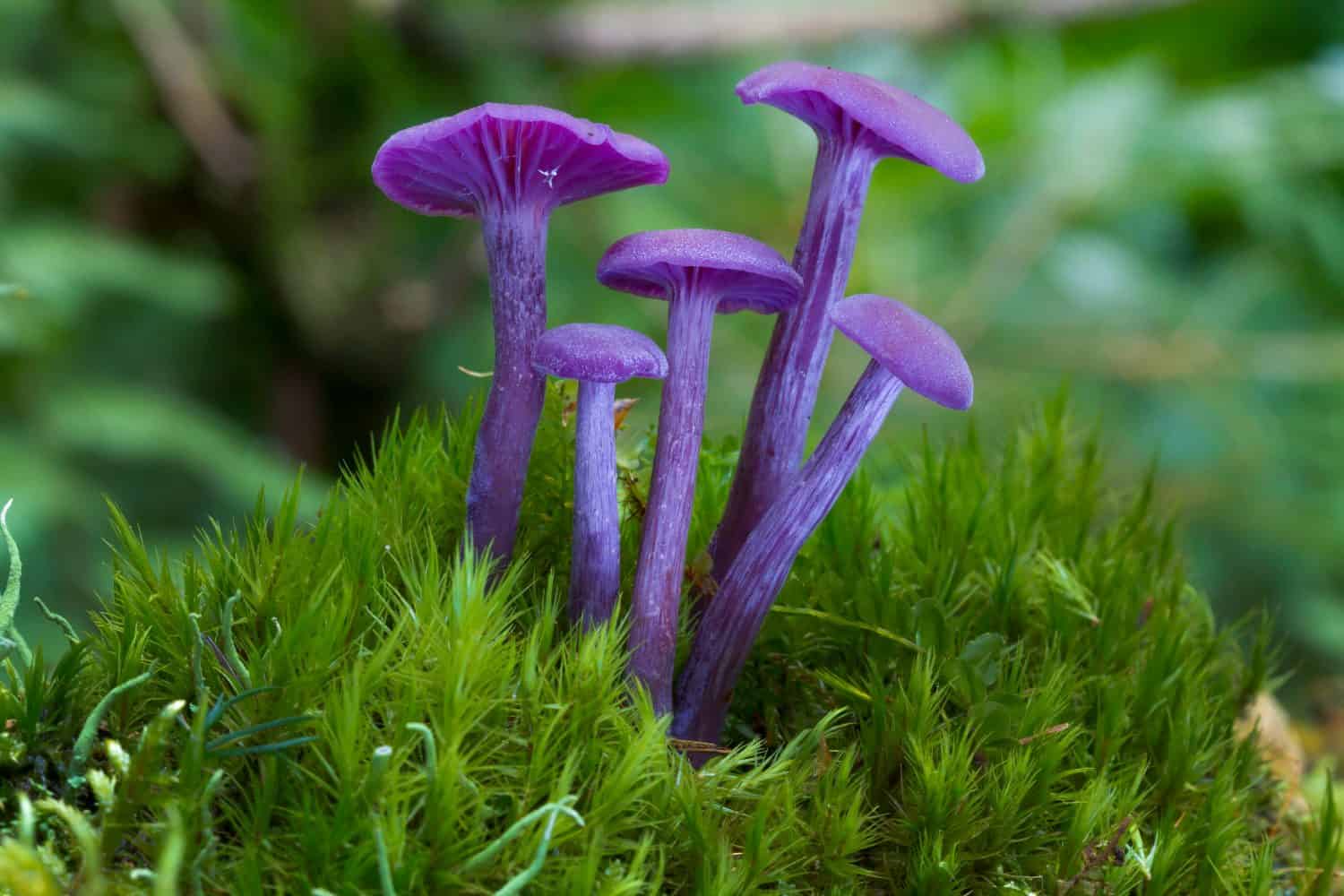
These purple mushrooms are common in Britain and Ireland.
©godi photo/Shutterstock.com
The amethyst deceiver is unique because of its deep purple coloration when wet. The mushroom turns a pale gray color when it dries out. The caps are large and almost flat when mature. The stems can grow to about 2-4 inches and often look hairy.
Yet, these mushrooms are called “deceiver” because their color fades with age. Their color change makes it more challenging to find and identify.
These mushrooms often grow in small clusters scattered around the same area. They are standard on the mainland of Europe, particularly in Britain and Ireland. You can also spot them in some regions of North America and Asia.
You’re most likely to find this mushroom growing amongst leaf litter. Still, they sometimes grow within moss.
William Hudson — an English botanist — was the first to discover the amethyst deceiver in 1778.
3. Bioluminescent Fungus (Mycena chlorophos)
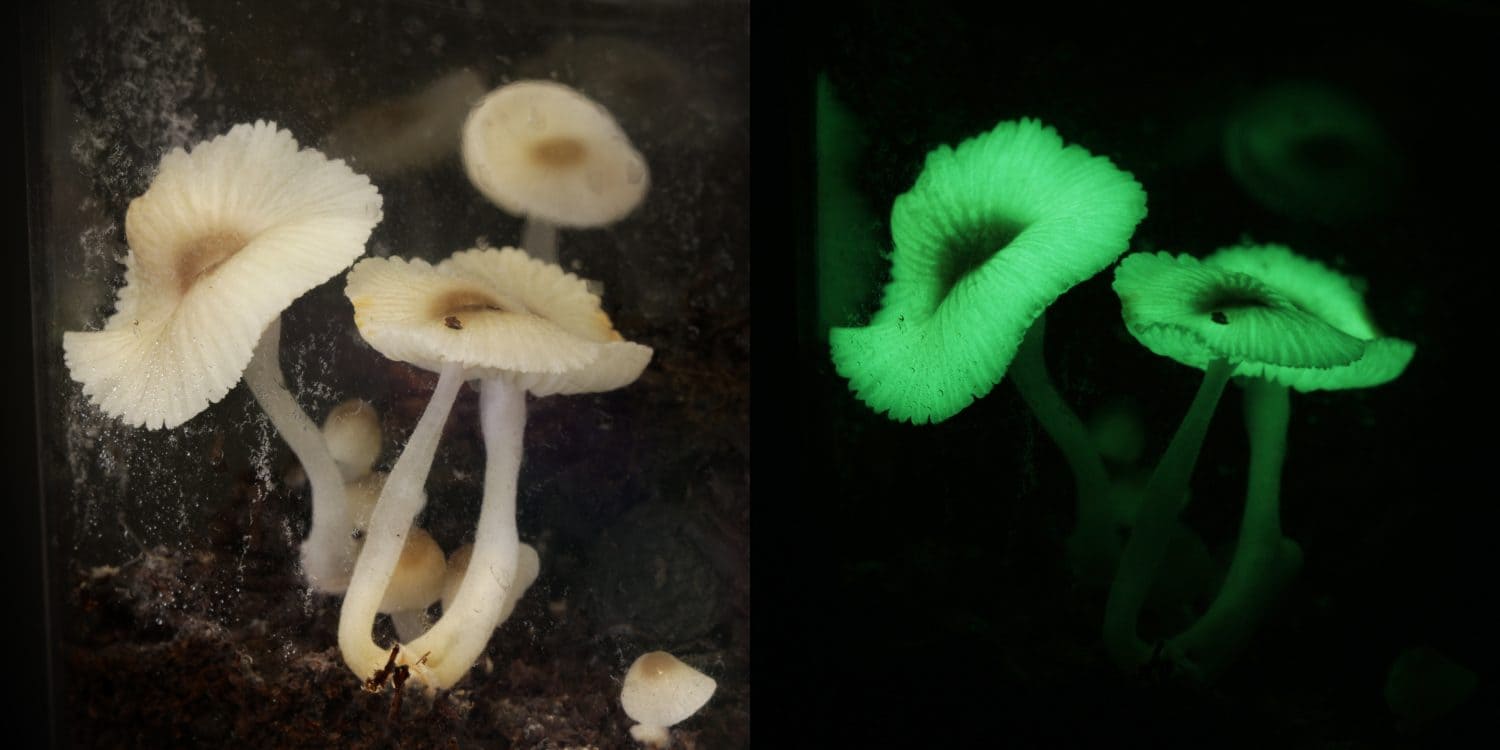
These mushrooms only glow at 81°F.
©bonchan/Shutterstock.com
These mushrooms are famous because they can glow in the dark. Their bioluminescent properties allow them to shine bright green — but only at a specific time. The mushroom will only burn once the cap forms and opens and if the temperature is 81°F.
Further, the glow only lasts for about a day, gradually fading until it is no longer noticeable.
Bioluminescent Fungi grow in Asia and the Pacific, where the temperatures are warm.
4. Bleeding Tooth (Hydnellum peckii)

The bleeding tooth mushroom secretes blood-red sap.
©iwciagr/Shutterstock.com
When young, the bleeding tooth has a whitish-pink cap topped with gelatinous-looking, blood-red balls. These “balls” are droplets of xylem sap that leak from the mushroom’s pores.
The mushrooms get their name “bleeding tooth” from the appearance of the leaking sap. Still, the mushrooms also resemble a yummy bakery treat oozing cherry filling.
The secretion of the sap dwindles as the mushrooms get older. The older the mushroom receives, the more gray it becomes.
But why does the sap leak out of the mushrooms? Sometimes, the soil the mushrooms live in becomes excessively wet. The excess moisture causes water to push up through the roots and the rest of the mushroom. The water moves upward in a process called “guttation.” The pressure of the water causes the sap out of the mushroom’s pores.
These mushrooms grow throughout North America, Europe, Korea, and Iran.
5. Blue Pinkgill (Entoloma hochstetteri)
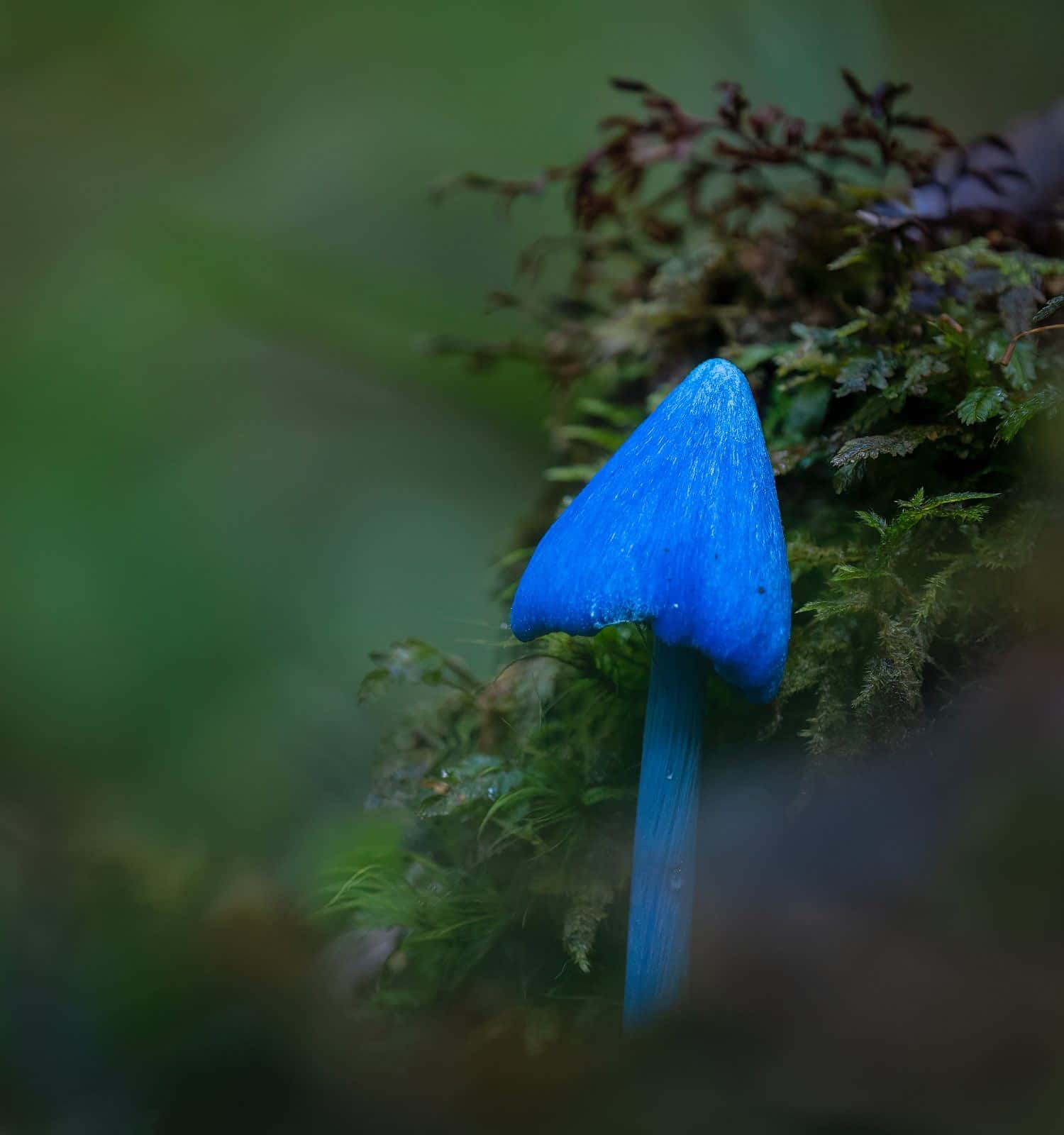
Blue pinkgill mushrooms are native to New Zealand and are named after the kōkako bird.
©Janice Chen/Shutterstock.com
The blue pinkgill mushroom is one of the prettiest on this list with its deep, iridescent blue coloration. The rich blue color comes from azulene pigments.
The cap is thick and round but ends in a sharp point at the top, giving it a unique shape. You’ll notice a slight reddish tint on the gills that comes from the spores.
This mushroom grows throughout India and New Zealand. The Aboriginal Māori people named it for their native kōkako bird. The mushroom’s blue color resembles the wattle of the bird. Initially, the Māori people called the mushroom the werewere-kokako.
The blue pinkgill is very important to New Zealand. The country features the mushroom on the back of their $50 note and some old stamps.
6. Brain Mushroom (Gyromitra esculenta)
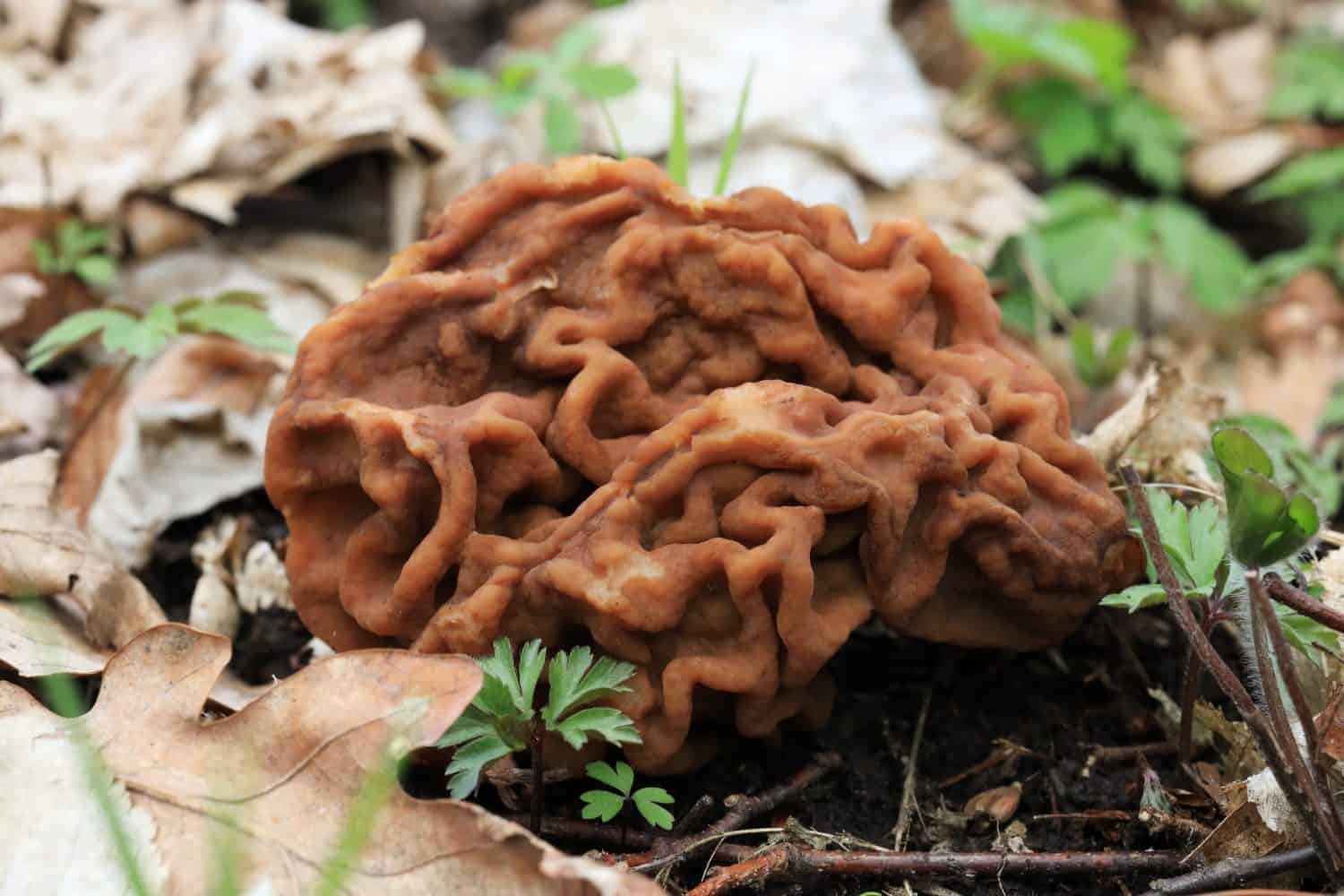
These wrinkly, pinkish-orange mushrooms look like brains.
©Tadeusz Mogielnicki/Shutterstock.com
These mushrooms get their name because their caps are wavy and shriveled, like a brain. Plus, how the cap sits on the stem resembles a brain connected to a brain stem.
Brain mushrooms grow throughout Europe, mainly in Britain and Ireland. They also grow in some parts of North America.
These mushrooms prefer to grow in mountainous areas amongst coniferous forests.
Brain mushrooms also go by the name “false morel.” They closely resemble actual morel mushrooms. Unfortunately, true morels are edible, while false morels are not. False morels — aka brain mushrooms — have round lobes that resemble wrinkles. True morels have ridges that are flat and more defined.
7. Cordyceps Militaris
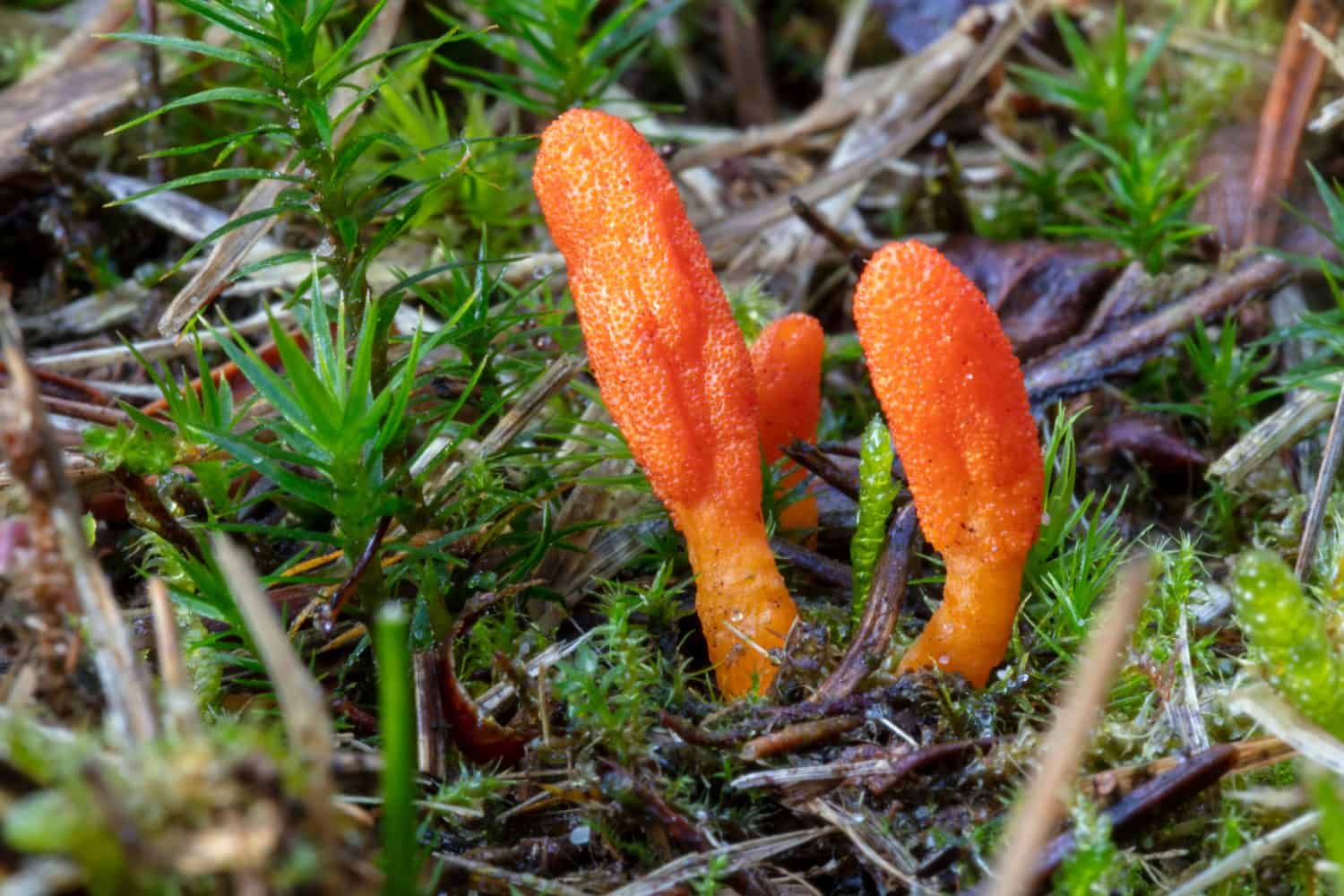
are parasitic mushrooms that grow inside insects.
©Edwin Butter/Shutterstock.com
These mushrooms are scarce — you will only find them in grasslands. The exciting thing about these mushrooms is that they don’t grow in soil. Instead, they are parasites extending from insects’ bodies and other parasites.
A few places cultivate these mushrooms — such as in the United States — though cultivation is still rare. Those who grow these mushrooms often use rice or silkworm moths as the growing source.
Despite these mushrooms being parasites, they are safe and edible. They are a popular ingredient in many soups; some even use them for medicine. As a medicine, Cordyceps militaris is useful for treating respiratory disorders. It is also helpful for improving immunity, which can help fight cancer.
Yet, because these mushrooms are so rare, they often cost between $600 and $800 per pound.
8. Devil’s Cigar (Chorioactis geaster)
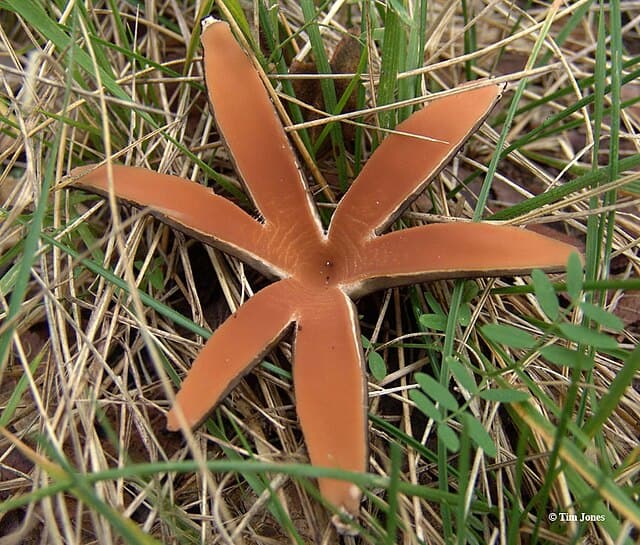
When it’s mature, the devil’s cigar mushroom looks like a brown flower.
©Tim Jones/CC BY 3.0 – License
The devil’s cigar is one of the rarest mushrooms on this list because it only grows in some areas of Japan and Texas. Researchers don’t understand the sparse and wide distribution of this mushroom.
These mushrooms are very picky about where they grow. In Texas, they typically grow on the dying stumps of Cedar elms in central and northern Texas.
The devil’s cigar gets its name because of the way it looks when it begins forming. Fuzzy, dark brown stems poke up from a stump, growing to about 3-4 inches long. The young, partially-formed mushroom looks very much like a cigar. As for why it’s called the “devil’s” cigar — that seems to be a mystery.
This mushroom is sometimes known as the “Texas Star” because of its shape. The mushroom is thin and paper-like, spreading like a star, similar to flower petals.
Today, the mushroom is known as the State Mushroom of Texas. The House and Senate officially voted it in. Only two other states have a state mushroom.
9. Dog Stinkhorn (Mutinus caninus)

Dog stinkhorns emit a foul smell that attracts bugs.
©iStock.com/Micalitus
These oddly named mushrooms are hard to see when they first pop up from the ground. The body is small and unassuming, lying in the leaf litter.
The mushroom develops an orangish-brown tip alongside its yellowish-pink body as it grows. Even more fascinating is what occurs once the mushroom’s egg structure breaks open. The mature part of the mushroom grows 4-5 inches in only five to six hours.
Not only is the tip of the mushroom a bold orange color — it stinks. Slime oozes from the end of the mushroom, carrying spores. The smelly slime entices insects that will pick up the spores and transport them further away, where they can grow into new mushrooms. Experts say the smell from the mushrooms is like the stink of uncleaned litter boxes.
It’s pretty clear why this mushroom goes by the name “stinkhorn,” but where did “dog” come from? Well, if you’ve ever seen a dog’s pink penis when it comes out of its prepuce — or sheath — you’ll know why.
Search for dog stinkhorns in eastern North America, Europe, and Asia.
10. Eastern Cauliflower Mushroom (Sparassis spathulata)
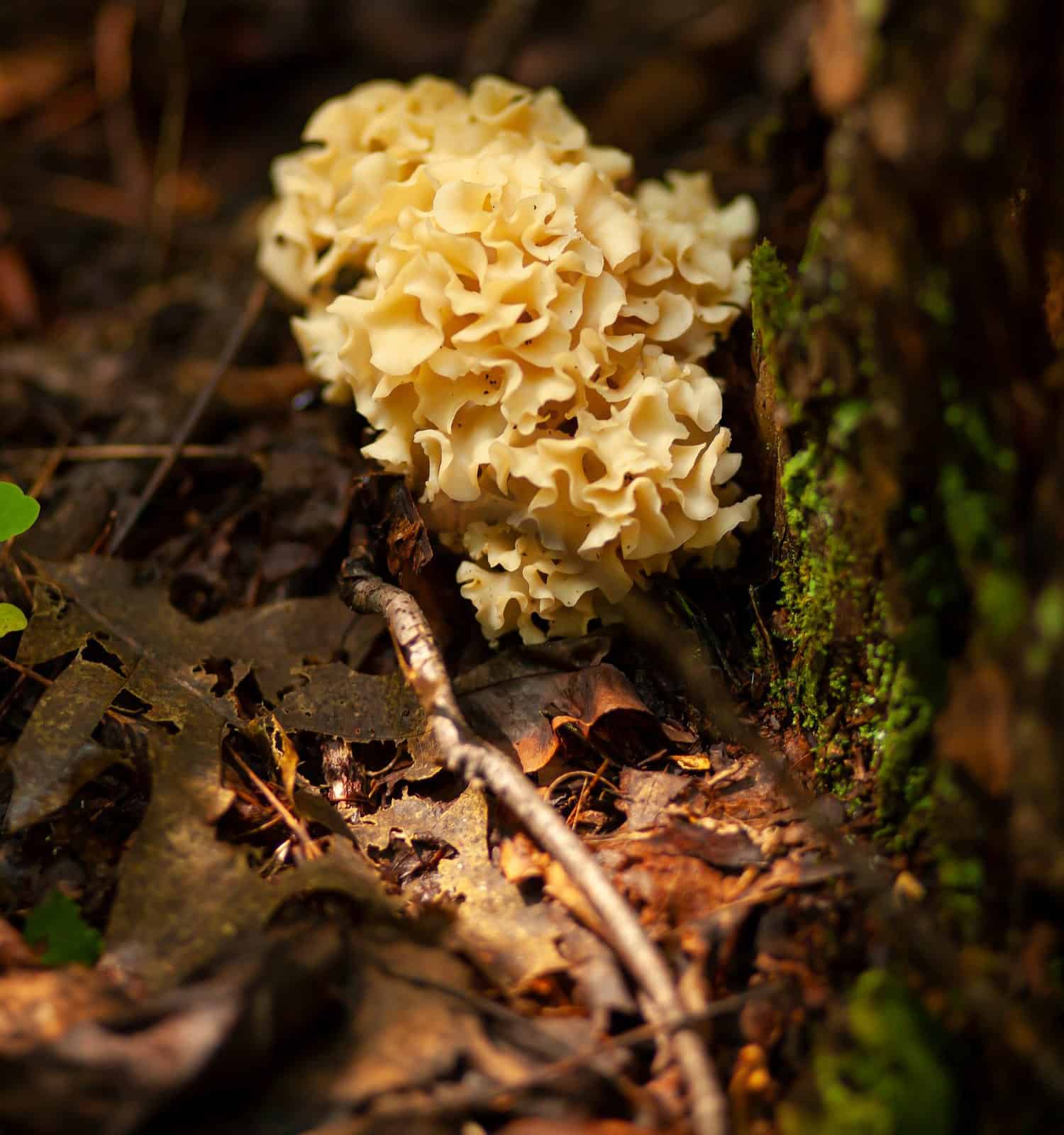
These mushrooms look a lot like cauliflower or noodles.
©grandbrothers/Shutterstock.com
The eastern cauliflower mushroom only grows in some parts of Japan, Korea, Australia, and the United States. These mushrooms get their name because they closely resemble the heads of cauliflower. If you look closely enough, their thick, white, wrinkly bodies resemble brains or corals.
These mushrooms are rare but have a light, savory taste that makes them suitable for cooking. They are popular in many Asian dishes, like ramen, soups, and salads.
11. European White Truffle (Tuber magnatum pico)
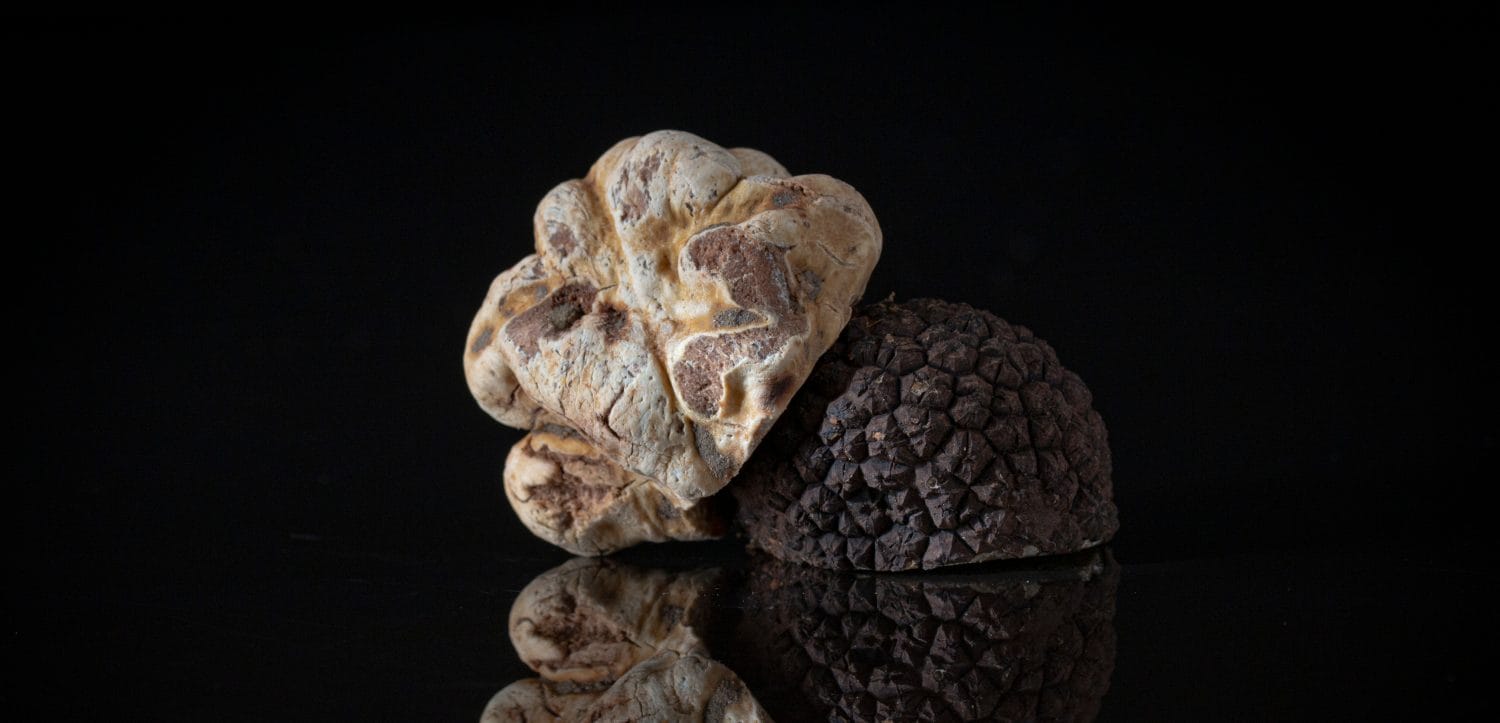
These mushrooms are some of the most expensive in the world.
©Fide Ernesto/Shutterstock.com
The European white truffle is one of the world’s most expensive and rare mushrooms. They are highly desirable edible mushrooms that cost around $4,000 to $7,000 per pound. Raw truffles are shaved and sprinkled over pasta, lobster, and filet mignon. Those who have eaten the truffle say it tastes like a combination of garlic and shallots.
Wild European white truffle mushrooms grow throughout Italy, Croatia, Bosnia, and Herzegovina. They are primarily found in Italy and only grow from September to December.
We call these mushrooms “truffles,” but they are whitish-brown and lumpy, like a potato.
12. Guchchi Mushroom (Morchella esculenta)
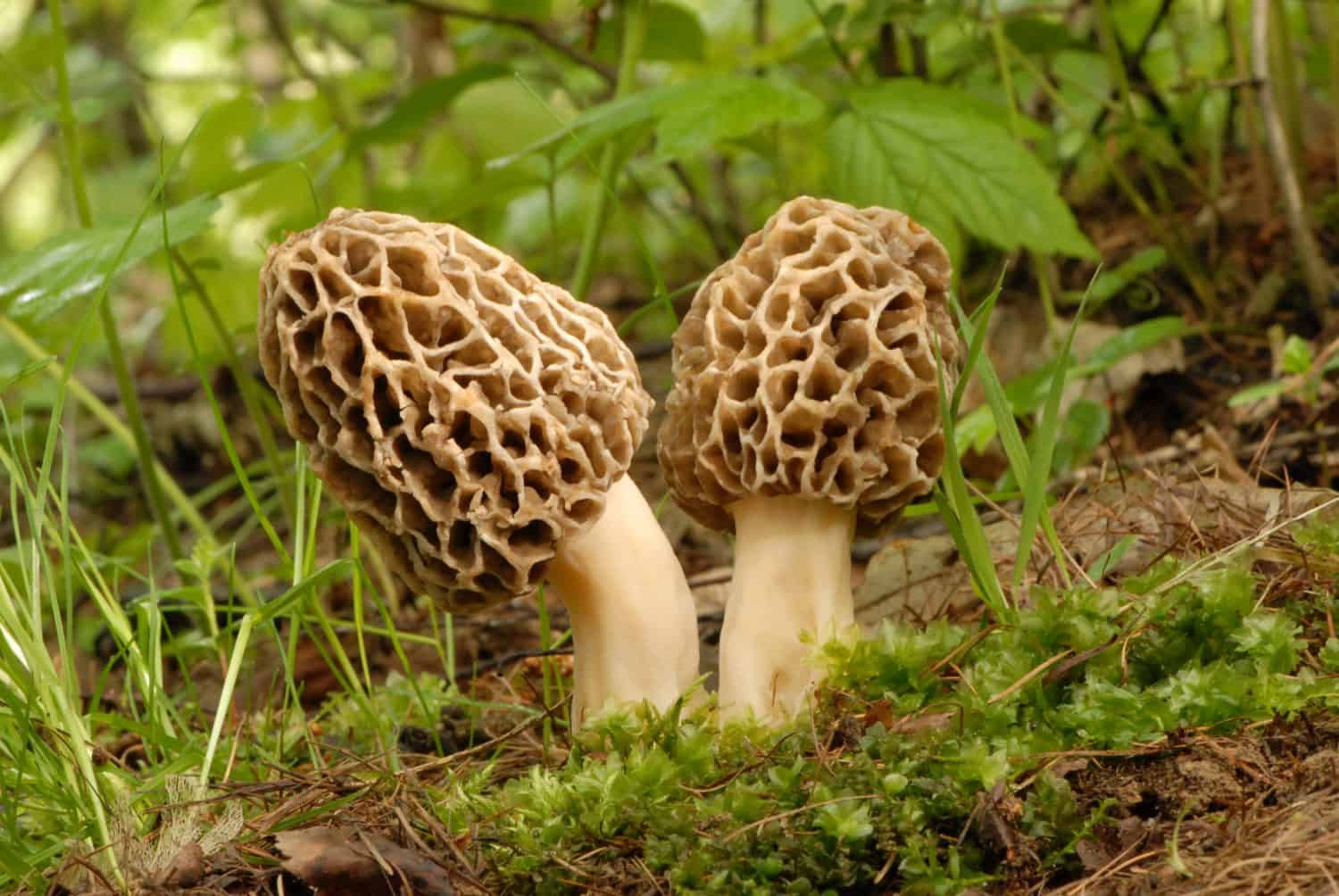
These shriveled brown mushrooms are very challenging to find.
©Tomasz Czadowski/Shutterstock.com
The Guchchi mushroom — also known as the morel — looks similar to a raisin or walnut with its wrinkled body.
These mushrooms grow in India and are pretty rare at about $300 per pound. They are among the most expensive mushrooms in India but also one of the best tasting. They are often used in a dish called Guchchi pulao.
These mushrooms are so expensive because they grow in unpredictable places. They must be collected from the wild and are hard to find. It is impossible to cultivate them.
Despite being so expensive, Guchchi mushrooms are vital for locals to make a living. Rural inhabitants collect the mushrooms and sell them.
Guchchi mushrooms taste great and are also suitable for your health. They are full of antioxidants, vitamins, and potassium. They help relieve gastric problems and joint pain and to heal wounds.
The Guchchi mushroom grows in the Himalayan Mountains across the Kangra Valley, Jammu, and Kashmir. They are resilient and cold-hardy fungi that grow through thick layers of snow.
13. Indigo Milk Cap (Lactarius indigo)
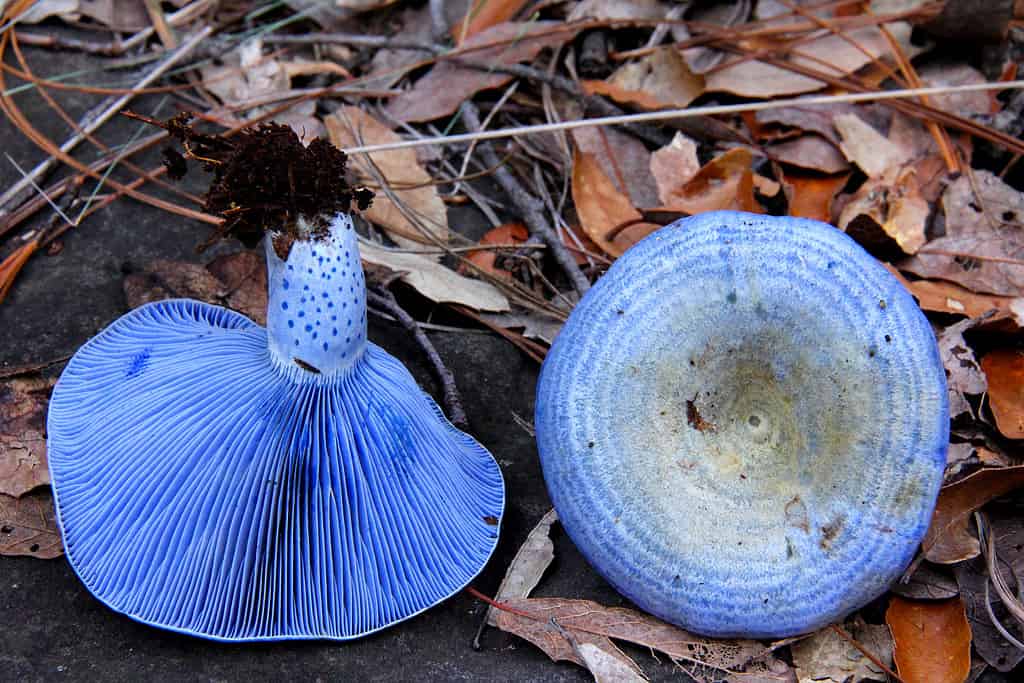
Indigo milk caps get their name because they secrete a milky liquid.
©Gajda/Shutterstock.com
The indigo milk cap gets its name because it is a bluish-purple, milky color. The bluer the mushroom is, the younger and fresher it is.
It also secretes an indigo-colored liquid latex that many refer to as “milk.” The milk slowly turns to a greenish color the longer it is exposed to air. The liquid only appears when you cut open the mushroom or it experiences a cut on the outside.
These mushrooms grow across North America, Central America, and East Asia.
14. Latticed Stinkhorn (Clathrus ruber)
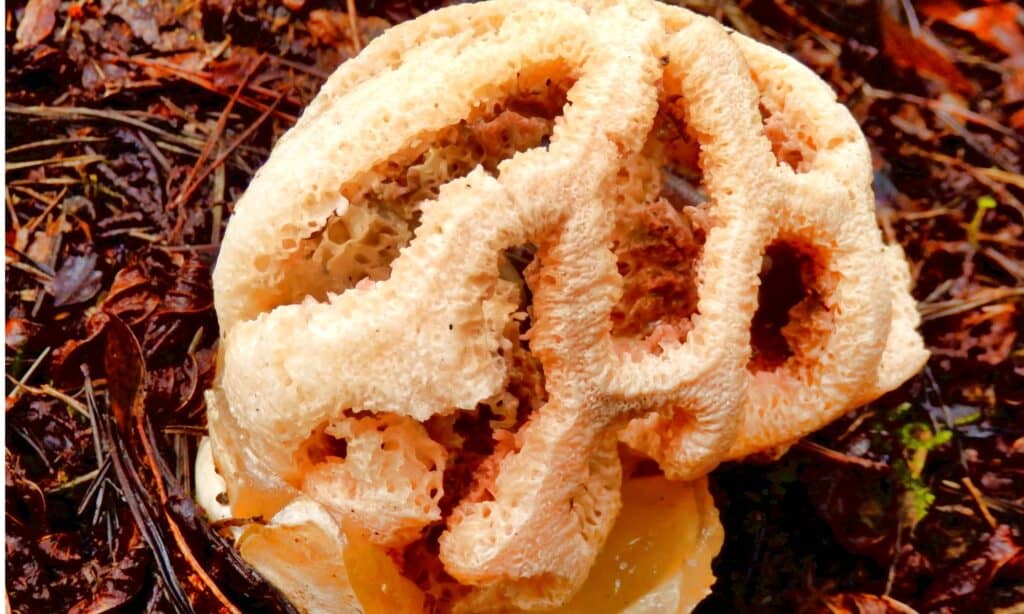
The latticed stinkhorn emits a smell like rotting meat.
©iStock.com/PlazacCameraman
These stinkhorn mushrooms are bright orange, squishy, sponge-like fungi. They have many large holes, creating a hollow body. They also use the name “basket stinkhorn” because of its open and latticed appearance.
Latticed stinkhorns grow in hot locations. They are common in the coastal regions of North America and the Mediterranean. Find it amongst leaf litter, mulch, or grass.
Like the dog stinkhorn, the latticed stinkhorn emits a foul odor. Those who have smelled the latticed stinkhorn describe the smell as rotting meat. Also, like the stinkhorn, the scent attracts insects that help spread the spores.
15. Lion’s Mane (Hericium erinaceus)
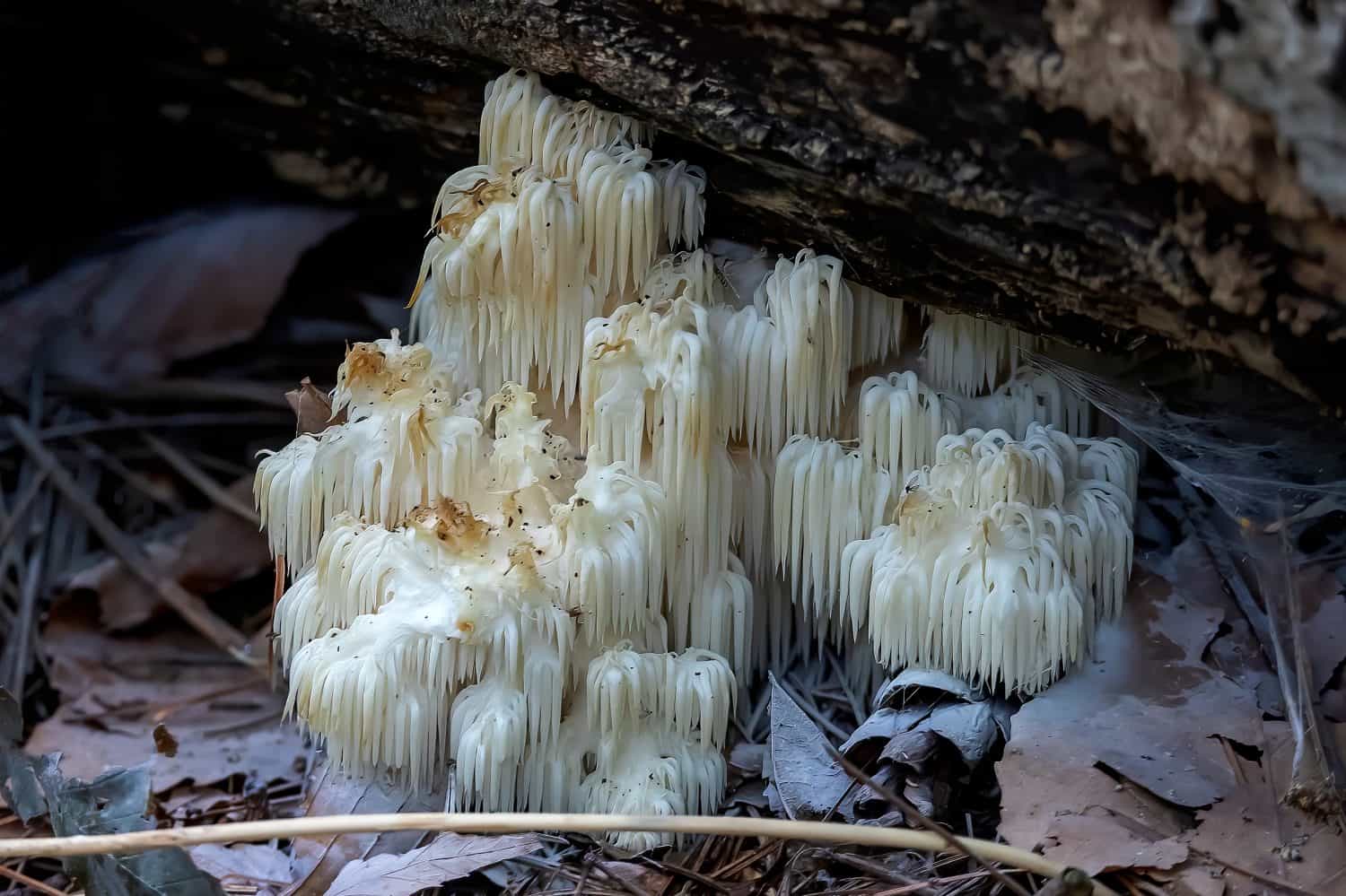
Lion’s mane mushrooms cascade, making them look like white waterfalls.
©Karel Bock/Shutterstock.com
These large mushrooms get their name because of their long, flowing, hair-like appearance. These long, stringy mushrooms are white or creamy with rounded bodies.
The “strings” are spines that all attach to the same spot. Lion’s mane mushrooms are “tooth fungi” — a group of fungi that grows the spine-like protrusions. The “spines” contain the spores that help the mushrooms reproduce.
Lion’s mane mushrooms have many health benefits. Experts say they help the gastrointestinal tract, heart, and brain. Healthline says they help prevent dementia, relieve anxiety and depression, and reduce ulcers.
Lion’s mane mushrooms grow on hardwood trees across North America, Europe, and Asia.
16. Matsutake Mushrooms (Tricholoma matsutake)

These expensive mushrooms are popular in many Japanese dishes.
©puttography/Shutterstock.com
Matsutake mushrooms are incredibly rare fungi that grow across North America and East Asia. One of the most expensive mushrooms on this list, Matsutake mushrooms cost between $1,000 and $2,000 per pound.
These tall, stocky mushrooms are expensive because they need particular growing needs.
These mushrooms are highly popular for Japanese dishes, both raw and cooked. They are delicacies with a spicy and fruity flavor. Matsutake mushrooms are often used in rice dishes and soup.
17. Pink Waxcap Mushroom (Porpolomopsis calyptriformis)
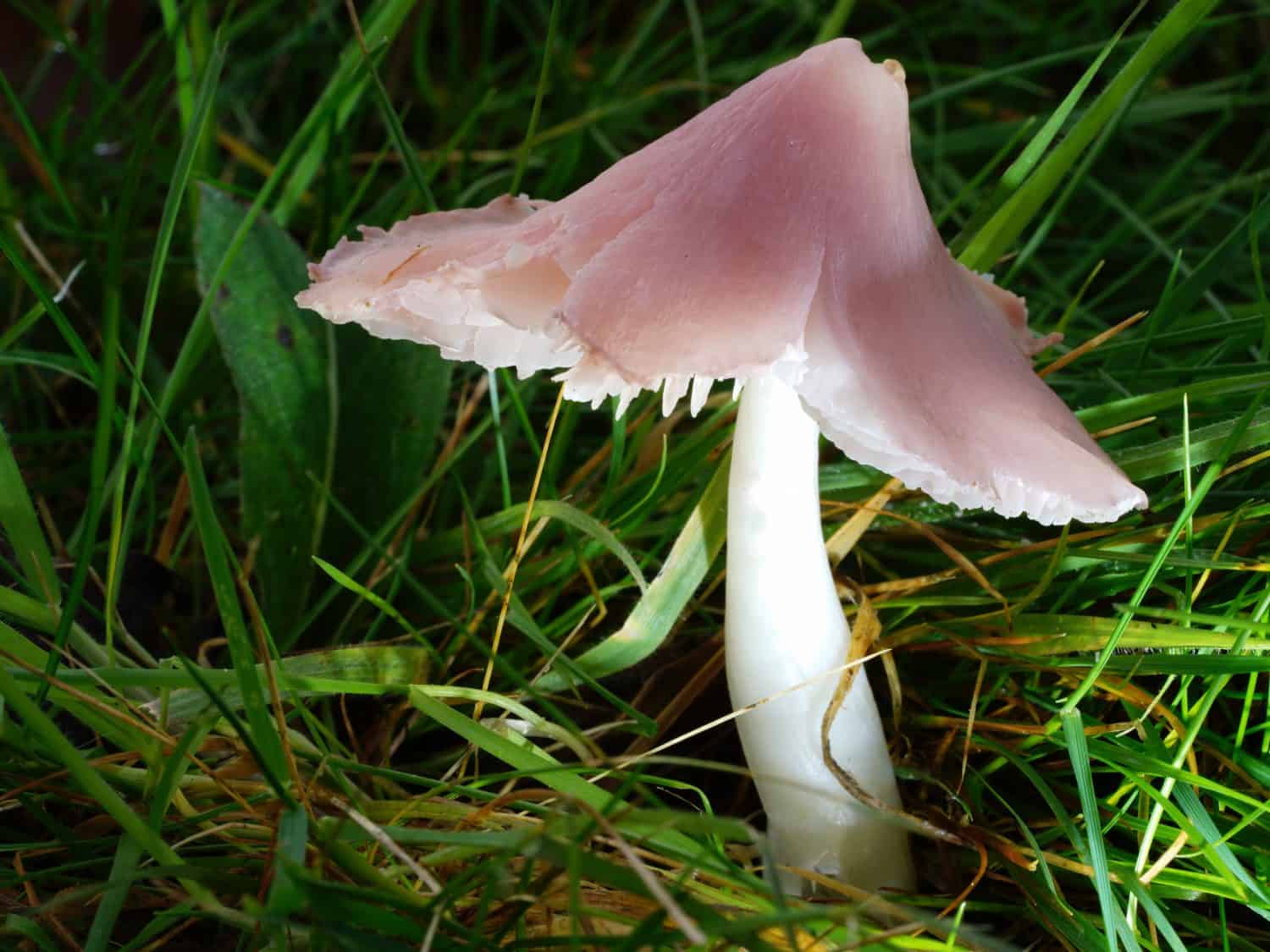
Pink waxcap mushrooms are delicate and look a lot like flowers.
©Graeme Pearce/Shutterstock.com
These mushrooms closely resemble flowers. They have a soft pink coloration and thin, petal-like caps. The caps also sit atop long, slender stems, reaching flower stems. The name “waxcap” comes from the waxy texture of the pink caps.
Pink waxcaps also go by “ballerina waxcap” and “pink ballerina.” The petal-like caps form frills that look like tutus.
Pink waxcap mushrooms are not toxic, but the government asks you not to pick them because they are rare. They grow across the grasslands of Great Britain and are most abundant from late summer to early autumn.
18. Poison Fire Coral (Podostroma cornu-damae)
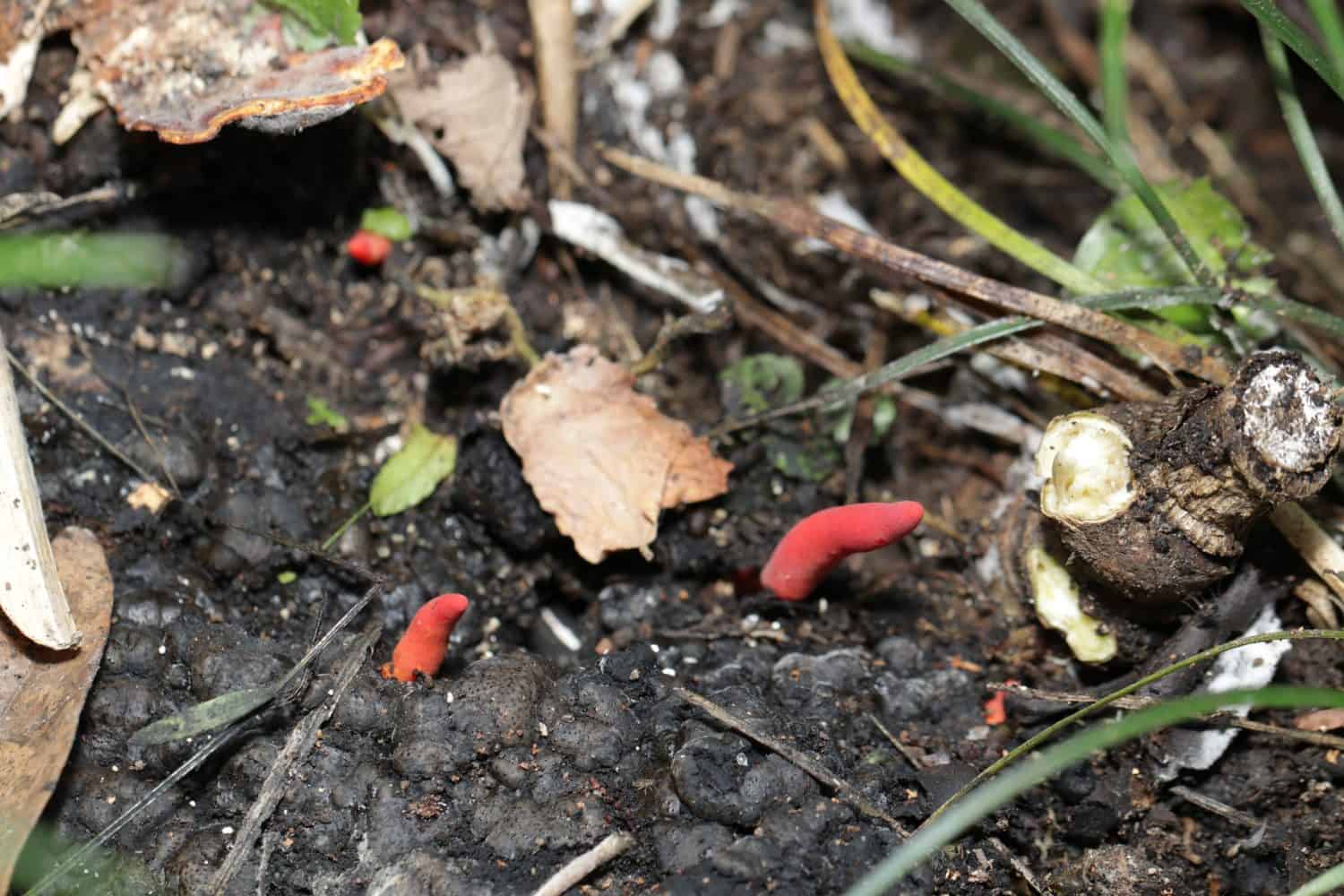
Poison fire coral mushrooms are highly toxic.
©saiglobalnt/Shutterstock.com
These mushrooms reach upward like the branches of deep-red corals. They are scarce but grow across Japan, Indonesia, and Korea.
As the name suggests, poison fire coral is not edible. It contains a toxic chemical that makes it incredibly fatal if someone ingests it. Ingestion causes severe symptoms like speech problems, hair loss, stomach pain, and peeling skin. Those who consume even small amounts of the mushroom almost always die.
People who harvest mushrooms in the area where the poison fire coral grows must be careful. It looks very similar to safe, edible mushrooms when it is young.
19. Puffball (Basidiomycota)
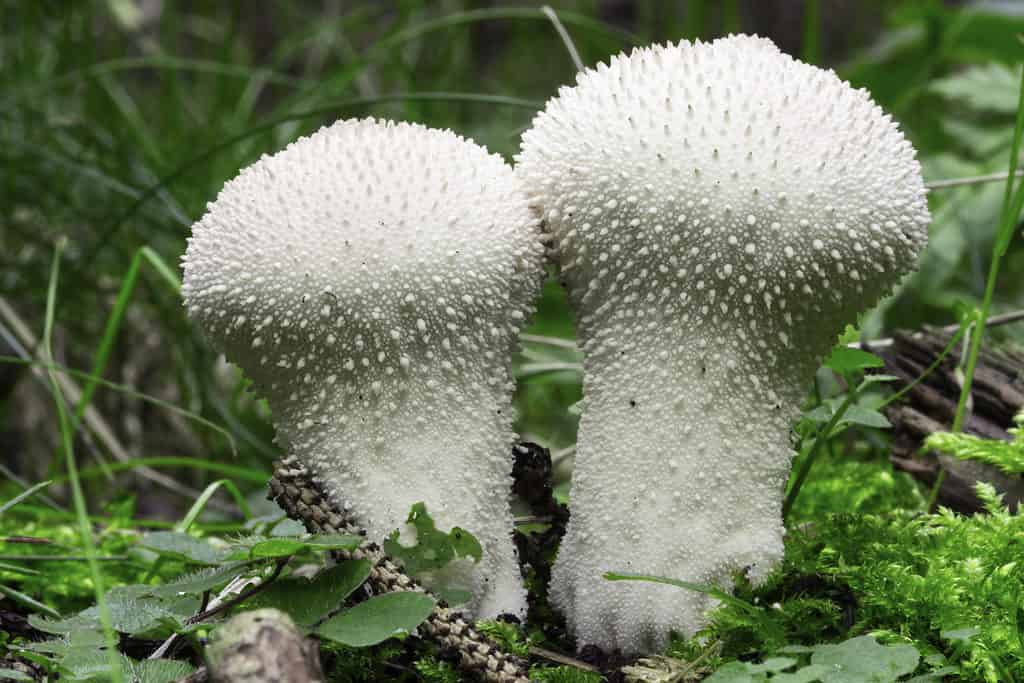
Large white puffball mushrooms release millions of spores at once.
©gstalker/Shutterstock.com
These large, white, round mushrooms have a fuzzy appearance. Puffball mushrooms don’t have large, flat caps with gills like most. Instead, the spores grow on the inside of the mushroom. The spores migrate to the outside when the mushroom is ready to release them. Then, the mushroom splits open to release the spores.
The name “puffball” comes from the puff of “smoke” that seemingly comes off the mushroom when it releases its spores. Puffball mushrooms release millions of spores at once. The spores can travel significantly before they land to grow new mushrooms.
20. Turkey Tail (Trametes versicolor)
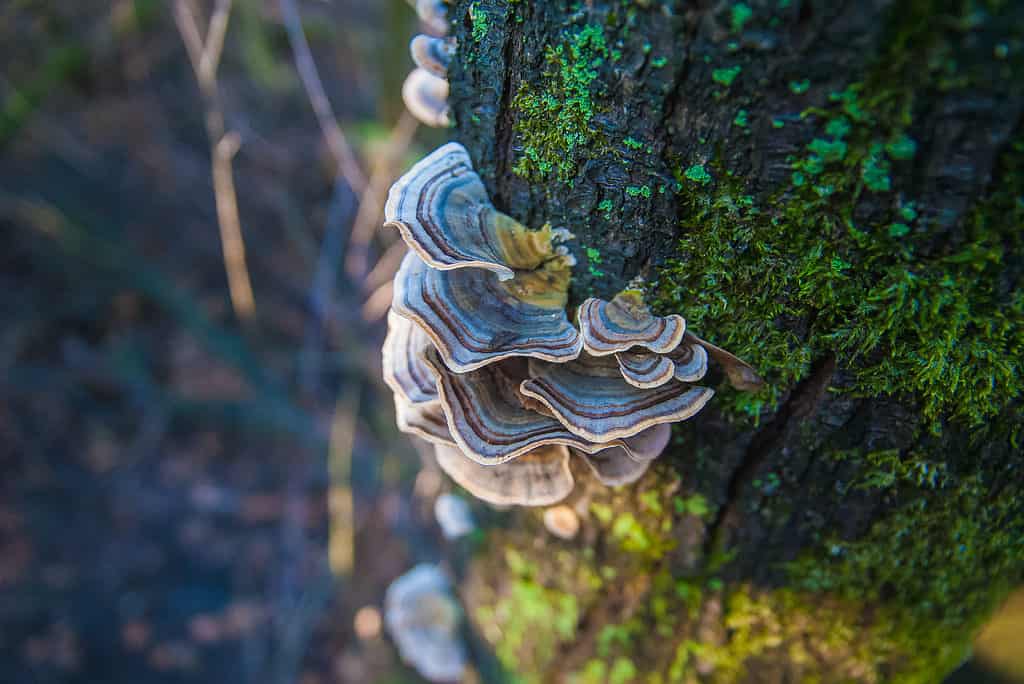
A turkey-tail mushroom growing from the side of a moss-covered tree trunk
©Slobodan Cvetkovic/Shutterstock.com
Turkey tail mushroom caps are half-moon-shaped and ruffled around the edges. They closely resemble turkey feathers. The caps have alternating stripes of blacks, grays, browns, greens, and yellows.
These turkey-like mushrooms are common throughout Europe, mainly in Britain and Ireland. You may also find them in Asia, North America, and northern Scandinavia through the Mediterranean.
These mushrooms grow throughout the year, but you’ll most likely spot them during the winter. They thrive on deciduous trees that lose their leaves in winter. The colorful stripes of the mushrooms are easy to spot in the absence of the leaves.
21. Veiled Lady (Phallus indusiatus)
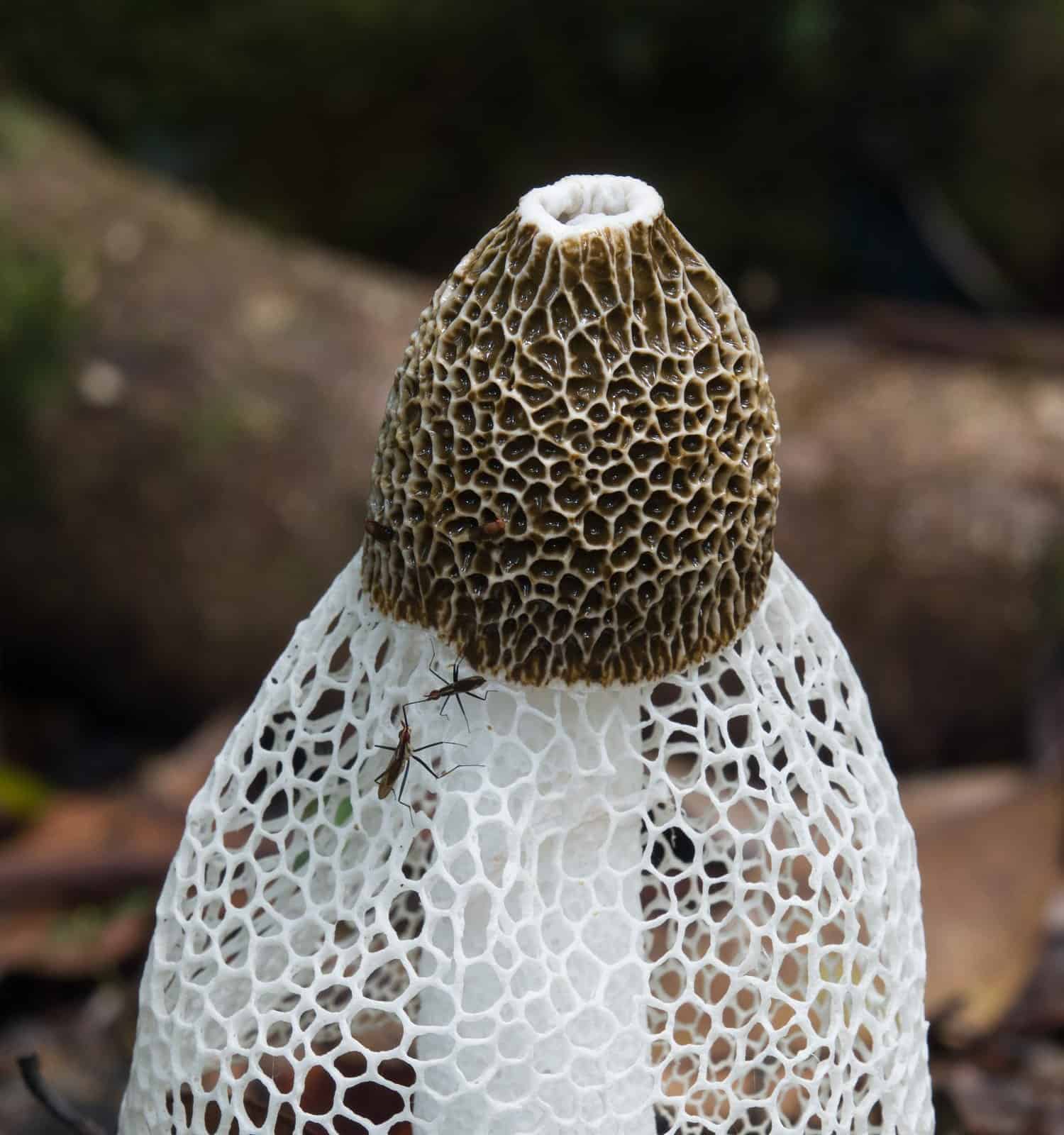
These delicate mushrooms look like a woman wearing a veil.
©Connie Pinson/Shutterstock.com
These mushrooms are some of the most elegant you can find. The upper cap of the mushroom is light brown and wrinkled. The lower part of the mushroom flares out like a puffy white veil. Small holes that look like polka dots or lace clutter the white portion of the mushroom. Altogether, the mushroom looks like a woman wearing a white veil.
This mushroom is a type of stinkhorn mushroom that emits a nasty smell. The cap has spores coated in slime that insects enjoy. Spores live inside the slime, which the insects carry away.
Interestingly, a 2001 study says the smell can trigger spontaneous orgasms in women.
22. Yartsa Gunbu (Ophiocordyceps sinensis)

These parasitic mushrooms grow inside caterpillars and are extremely expensive.
©PattyPhoto/Shutterstock.com
The Yartsa Gunbu mushroom is one of this list’s rarest and most expensive.
People grind the mushroom into a powder and use it in soups and teas. They also use it to garnish some dishes.
Yet, this mushroom is reserved for the truly wealthy, as it sells for about $50,000 a pound. The Chinese often call the mushroom “soft gold.”
The Yartsa Gunbu mushroom also has medicinal properties. It has anti-inflammatory and antioxidant properties, among others.
Many call the Yartsa Gunbu the “Summer grass winter worm.” It is a parasitic mushroom that attaches to ghost moth caterpillars. Eventually, the mushroom grows inside the caterpillar and kills it.
Summary of the 22 Amazing Types of Rare Mushrooms
| Mushroom | Scientific Name | Where they Grow |
|---|---|---|
| Nouhra’s Truffle-like Amanita | Amanita nouhrae | Argentina, Chile |
| Amethyst Deceiver | Laccaria amethystina | Europe (Britain and Ireland), North America, Asia |
| Bioluminescent Fungus | Mycena chlorophos | Asia, The Pacific |
| Bleeding Tooth | Hydnellum peckii | North America, Europe, Korea, Iran |
| Blue Pinkgill | Entoloma hochstetteri | New Zealand, India |
| Brain Mushroom | Gyromitra esculentra | Europe (Britain and Ireland), North America |
| Cordyceps militaris | Cordyceps militaris | |
| Nouhra’s Truffle-like Amanita | Chorioactis geaster | Texas, Japan |
| Dog Stinkhorn | Mutinus caninus | North America, Europe, Asia |
| Eastern Cauliflower Mushroom | Sparassis crispa | Japan, Korea, Australia, United States |
| European White Truffle | Tuber Magnatum Pico | Italy, Croatia, Bosnia, Herzegovina |
| Guchchi Mushroom | Morchella esculenta | Himalayan Mountains — Kangra Valley, Jammu, Kashmir |
| Indigo Milk Cap | Lactarius indigo | North America, Central America, East Asia |
| Latticed Stinkhorn | Clathrus ruber | Coastal North America, The Mediterranean |
| Devil’s Cigar | Hericium erinaceus | North America, Europe, Asia |
| Matsutake Mushrooms | Tricholoma matsutake | North America, East Asia |
| Pink Waxcap Mushroom | Porpolomopsis calyptriformis | Great Britain grasslands |
| Poison Fire Coral | Podostroma cornu-damae | Japan, Indonesia, Korea |
| Puffball | Basidiomycota | Worldwide |
| Turkey Tail | Trametes versicolor | Europe (Britain, Ireland, Northern Scandinavia), North America, Asia, Mediterranean |
| Veiled Lady | Phallus indusiatus | North America, South America, Asia, Africa, Australia |
| Yartsa Gunbu | Ophiocordyceps sinensis | Lion’s Mane |
The photo featured at the top of this post is © Karel Bock/Shutterstock.com
The information presented on or through the Website is made available solely for general informational purposes. We do not warrant the accuracy, completeness, or usefulness of this information. Any reliance you place on such information is strictly at your own risk. We disclaim all liability and responsibility arising from any reliance placed on such materials by you or any other visitor to the Website, or by anyone who may be informed of any of its contents. None of the statements or claims on the Website should be taken as medical advice, health advice, or as confirmation that a plant, fungus, or other item is safe for consumption or will provide any health benefits. Anyone considering the health benefits of particular plant, fungus, or other item should first consult with a doctor or other medical professional. The statements made within this Website have not been evaluated by the Food and Drug Administration. These statements are not intended to diagnose, treat, cure or prevent any disease.
Thank you for reading! Have some feedback for us? Contact the AZ Animals editorial team.



